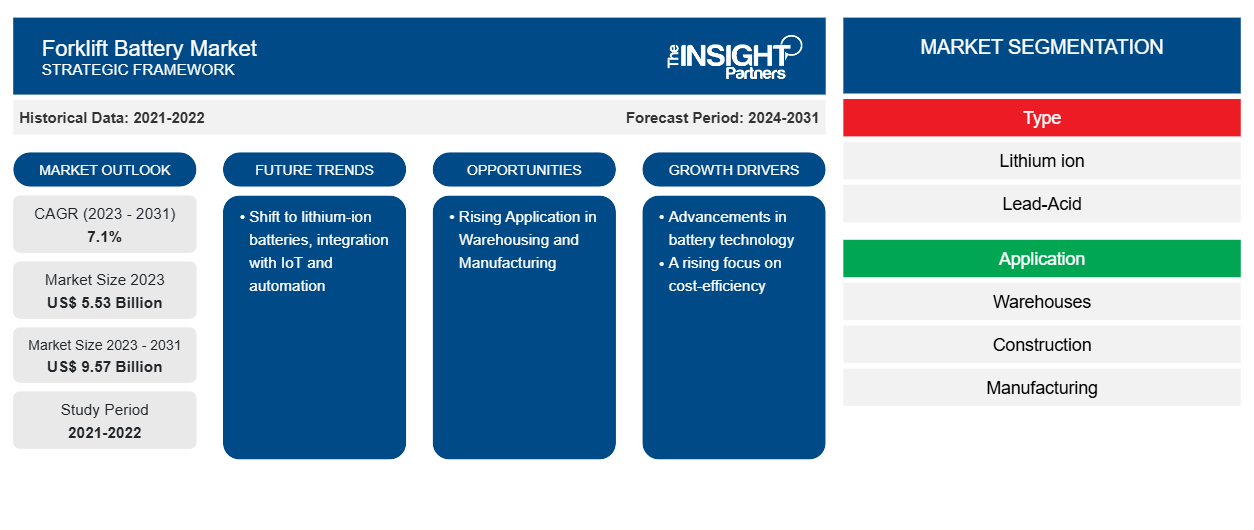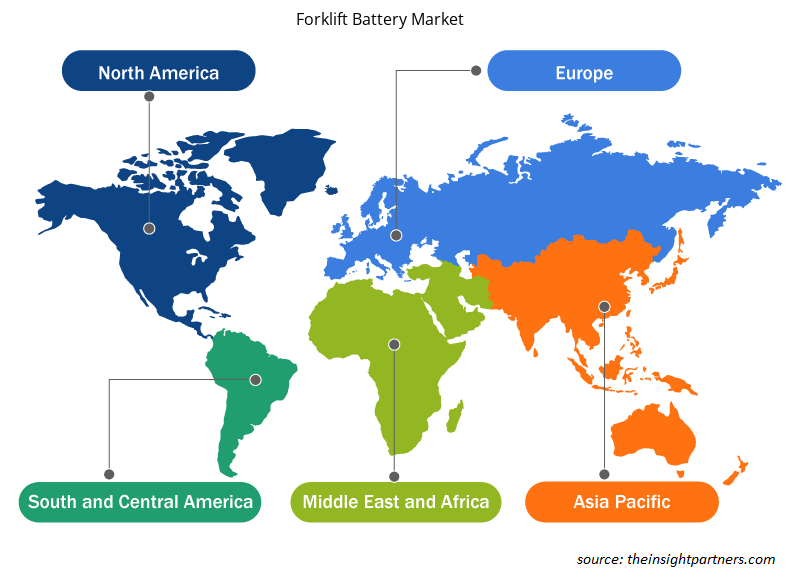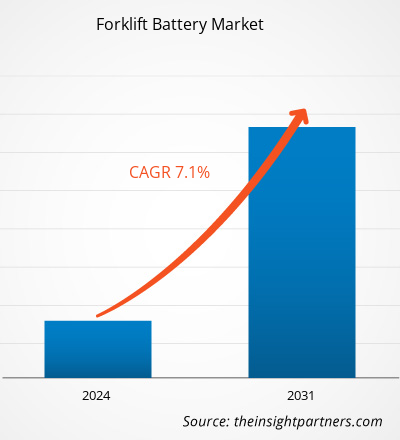Nel 2024, il mercato delle batterie per carrelli elevatori ha raggiunto i 5,94 miliardi di dollari USA e si prevede che raggiungerà i 9,23 miliardi di dollari USA entro il 2031; si stima un CAGR del 6,6% dal 2025 al 2031. L'integrazione della batteria come servizio (BaaS) nei carrelli elevatori porterà probabilmente nuove tendenze sul mercato nei prossimi anni.
Analisi del mercato delle batterie per carrelli elevatori
Il mercato delle batterie per carrelli elevatori sta vivendo una crescita significativa, trainata dalla rapida espansione dei settori dello stoccaggio e dell'e-commerce, dalla crescente industrializzazione e da una transizione globale verso i carrelli elevatori elettrici per garantire sostenibilità ed efficienza dei costi. Queste tendenze stanno alimentando la domanda di soluzioni di batterie avanzate per supportare orari di funzionamento più lunghi e ridurre le emissioni. Le opportunità di mercato includono lo sviluppo di tecnologie di ricarica rapida e di ricarica continua, che riducono i tempi di fermo e migliorano la produttività. Inoltre, le innovazioni nei sistemi di gestione intelligente delle batterie stanno migliorando le prestazioni, la sicurezza e l'efficienza energetica. Questi progressi offrono prospettive promettenti per produttori e stakeholder che mirano a soddisfare le esigenze in continua evoluzione del settore della movimentazione dei materiali.
Panoramica del mercato delle batterie per carrelli elevatori
Una batteria per carrelli elevatori può fungere da fonte di alimentazione per il funzionamento di carrelli elevatori e altri veicoli industriali, fornendo l'energia necessaria per le operazioni di movimentazione dei materiali. I carrelli elevatori utilizzano in genere batterie al piombo-acido o agli ioni di litio (Li-ion), queste ultime più diffuse grazie alla loro capacità di ricarica più rapida, alla maggiore durata e al ridotto impatto ambientale, tra gli altri vantaggi. La domanda di batterie per carrelli elevatori è cresciuta significativamente con la crescente popolarità dei carrelli elevatori elettrici, preferiti per la loro sostenibilità, la minore necessità di manutenzione e l'economicità rispetto ai tradizionali carrelli elevatori con motore a combustione interna (ICE). Le industrie europee e nordamericane sono note per la loro attenzione a soluzioni più ecologiche per ridurre le proprie emissioni di carbonio, il che contribuisce ad aumentare la domanda di carrelli elevatori elettrici. Le batterie per carrelli elevatori svolgono un ruolo fondamentale nei settori della logistica, dello stoccaggio e della produzione, dove alimentano diverse macchine essenziali per la movimentazione e il trasporto dei materiali. Oltre alla crescente adozione di carrelli elevatori elettrici, l'aumento dell'automazione nei magazzini in diversi settori industriali sostiene la crescita del mercato.
Riceverai la personalizzazione gratuita di qualsiasi report, incluse parti di questo report, analisi a livello nazionale, pacchetto dati Excel e potrai usufruire di fantastiche offerte e sconti per start-up e università.
Mercato delle batterie per carrelli elevatori: approfondimenti strategici

-
Scopri le principali tendenze di mercato di questo rapporto.Questo campione GRATUITO includerà analisi di dati che spaziano dalle tendenze di mercato alle stime e alle previsioni.
Driver e opportunità del mercato delle batterie per carrelli elevatori
Espansione dell'immagazzinamento e dell'e-commerce
Il settore dell'e-commerce sta fiorendo grazie alla crescente diffusione di Internet e degli smartphone, all'evoluzione delle preferenze dei consumatori e ai progressi tecnologici. Inoltre, l'e-commerce transfrontaliero è in crescita, poiché i consumatori cercano prodotti unici a prezzi competitivi a livello internazionale. Secondo Eurostat, nell'UE la quota di aziende che hanno adottato strategie di vendita online è aumentata dal 17,21% nel 2013 al 23,83% nel 2023. Molte aziende di e-commerce stanno aprendo magazzini in tutto il mondo. Ad esempio, Amazon, un gigante dell'e-commerce, ha inaugurato il suo primo centro di distribuzione nei Paesi Bassi nell'agosto 2023. Grazie alla nuova struttura, il mercato online sarà in grado di soddisfare le richieste olandesi senza ritardi. La rapida crescita dell'e-commerce ha portato a una crescente domanda di soluzioni di movimentazione dei materiali efficienti e pulite nei magazzini. Aziende come Amazon e DHL stanno rispondendo implementando flotte di carrelli elevatori a batteria per migliorare l'efficienza operativa e ridurre l'impatto ambientale. Ad esempio, a marzo 2022, DHL Supply Chain ha introdotto la sua nuova gamma di carrelli elevatori autonomi nell'Europa continentale; questi carrelli elevatori per pallet sono stati l'ultima aggiunta al suo magazzino multiutente di Bornem, in Belgio. L'installazione di trasportatori robotici autonomi per interni per la movimentazione di pallet faceva parte della strategia di digitalizzazione accelerata dell'azienda. Pertanto, l'impennata degli acquisti online sta rimodellando il panorama logistico, spingendo le aziende a investire in magazzini automatizzati e carrelli elevatori a batteria. Questo cambiamento ha un impatto diretto sulla domanda di batterie per carrelli elevatori efficienti e durevoli, in particolare agli ioni di litio e al piombo-acido, per supportare le operazioni 24 ore su 24.
Sviluppi nelle funzionalità di ricarica rapida e di opportunità
Con la crescente diffusione dei carrelli elevatori elettrici in tutto il mondo, si sta diffondendo l'attenzione verso soluzioni di ricarica avanzate, come la ricarica rapida e la ricarica di opportunità. Questi metodi si rivelano preziosi per le aziende con attività su più turni grazie alla loro capacità di ridurre i tempi di fermo e migliorare l'efficienza. Tradizionalmente, le batterie dei carrelli elevatori seguono un ciclo di ricarica convenzionale, che include 8 ore di funzionamento, 8 ore di ricarica e altre 8 ore di raffreddamento. Questo ciclo limita la disponibilità della batteria e spesso richiede alle aziende di acquistare batterie aggiuntive per mantenere le operazioni su più turni, aumentando sia i costi che le esigenze di stoccaggio. I metodi di ricarica rapida e di opportunità affrontano questa sfida consentendo agli operatori dei carrelli elevatori di collegarsi durante brevi pause, pasti o durante le ore notturne. Questo aiuta a mantenere la carica della batteria tra il 40 e l'80%, mantenendo i carrelli elevatori disponibili per l'uso durante tutto il giorno. Per mantenere la batteria in buone condizioni e garantire le massime prestazioni, è comunque importante eseguire una carica di equalizzazione settimanale, che porta la batteria a una carica completa al 100% e aiuta a prevenire l'accumulo di solfati.
Poiché sempre più aziende cercano di migliorare i tempi di attività e ridurre i costi operativi, si prevede che la domanda di batterie e sistemi di ricarica compatibili con questi metodi aumenterà. Pertanto, il passaggio a ricariche rapide e di opportunità rappresenta un'importante opportunità di crescita per il mercato delle batterie per carrelli elevatori.
Analisi della segmentazione del rapporto di mercato delle batterie per carrelli elevatori
I segmenti chiave che hanno contribuito alla derivazione dell'analisi del mercato delle batterie per carrelli elevatori sono tipo, capacità e applicazione.
- In base alla tipologia, il mercato delle batterie per carrelli elevatori è segmentato in batterie agli ioni di litio, al piombo e altre. Il segmento al piombo ha dominato il mercato nel 2024.
- In base alla capacità, il mercato delle batterie per carrelli elevatori è suddiviso in 0-600 Ah, 600-1.200 Ah e oltre 1.200 Ah. Il segmento 0-600 Ah deteneva la quota di mercato maggiore nel 2024.
- In base all'applicazione, il mercato delle batterie per carrelli elevatori è segmentato in magazzini e logistica, edilizia, produzione, commercio al dettaglio e all'ingrosso, automotive e altri settori. Il settore manifatturiero ha dominato il mercato nel 2024.
Analisi della quota di mercato delle batterie per carrelli elevatori per area geografica
- Il mercato delle batterie per carrelli elevatori è segmentato in cinque regioni principali: Nord America, Europa, Asia-Pacifico (APAC), Medio Oriente e Africa (MEA) e Sud e Centro America. L'Asia-Pacifico ha dominato il mercato nel 2024, seguita da Europa e Nord America.
- La crescita del mercato nordamericano delle batterie per carrelli elevatori è attribuibile all'espansione dei settori della logistica, dei trasporti e dell'e-commerce. Negli ultimi anni, lo shopping online negli Stati Uniti è aumentato. L'Ufficio del Censimento del Dipartimento del Commercio ha annunciato che la stima delle vendite al dettaglio dell'e-commerce negli Stati Uniti per il quarto trimestre del 2024, al netto delle variazioni stagionali ma non dei prezzi, ammontava a 308,9 miliardi di dollari, con un aumento del 2,7% (±0,9) rispetto al terzo trimestre del 2024. Molti colossi della logistica presenti sul mercato, come UPS, FedEx, USPS, XPO Logistics e Amazon, hanno riconosciuto la crescente domanda di carrelli elevatori nei loro magazzini. Queste aziende hanno investito in modo significativo nell'implementazione dei magazzini e nell'automazione delle operazioni logistiche. Ad esempio, nel novembre 2023, United Parcel Service ha aperto il più grande magazzino a Louisville, Kentucky, con una superficie di circa 20 acri. Questo magazzino è progettato per lo stoccaggio e la movimentazione dei pacchi, con un investimento significativo di 79 milioni di dollari per l'installazione di oltre 3.000 robot automatizzati e veicoli industriali. Questi robot e veicoli industriali gestiranno diverse attività di magazzino, come il sollevamento e il trasporto delle merci da un luogo all'altro, riducendo la necessità di lavoro manuale.
- Il mercato delle batterie per carrelli elevatori in Europa è trainato dalla crescita del settore alimentare e delle bevande, dalla crescente domanda di logistica e trasporti e dalla crescita del settore del commercio al dettaglio. Il settore della logistica richiede veicoli industriali come i carrelli elevatori per sollevare e trasportare merci da un luogo all'altro. Secondo le statistiche pubblicate dalla Commissione Europea a luglio 2024, sono stati investiti 7,97 miliardi di dollari in 134 progetti infrastrutturali di trasporto per infrastrutture sostenibili, sicure e intelligenti. L'investimento strategico dell'UE è stato effettuato per automatizzare le infrastrutture di trasporto e logistica. La crescita del settore della logistica ha creato una domanda di carrelli elevatori elettrici per la movimentazione dei materiali nei magazzini, che, a sua volta, traina la crescita del mercato delle batterie per carrelli elevatori.
Approfondimenti regionali sul mercato delle batterie per carrelli elevatori
Le tendenze e i fattori regionali che influenzano il mercato delle batterie per carrelli elevatori durante il periodo di previsione sono stati ampiamente spiegati dagli analisti di Insight Partners. Questa sezione illustra anche i segmenti e la distribuzione geografica del mercato delle batterie per carrelli elevatori in Nord America, Europa, Asia-Pacifico, Medio Oriente e Africa, e Sud e Centro America.

- Ottieni i dati specifici regionali per il mercato delle batterie per carrelli elevatori
Ambito del rapporto sul mercato delle batterie per carrelli elevatori
| Attributo del report | Dettagli |
|---|---|
| Dimensioni del mercato nel 2024 | 5,94 miliardi di dollari USA |
| Dimensioni del mercato entro il 2031 | 9,23 miliardi di dollari USA |
| CAGR globale (2025-2031) | 6,6% |
| Dati storici | 2021-2023 |
| Periodo di previsione | 2025-2031 |
| Segmenti coperti |
Per tipo
|
| Regioni e paesi coperti |
America del Nord
|
| Leader di mercato e profili aziendali chiave |
|
Densità degli operatori del mercato delle batterie per carrelli elevatori: comprendere il suo impatto sulle dinamiche aziendali
Il mercato delle batterie per carrelli elevatori è in rapida crescita, trainato dalla crescente domanda degli utenti finali, dovuta a fattori quali l'evoluzione delle preferenze dei consumatori, i progressi tecnologici e una maggiore consapevolezza dei vantaggi del prodotto. Con l'aumento della domanda, le aziende stanno ampliando la propria offerta, innovando per soddisfare le esigenze dei consumatori e sfruttando le tendenze emergenti, alimentando ulteriormente la crescita del mercato.
La densità degli operatori di mercato si riferisce alla distribuzione delle imprese che operano in un determinato mercato o settore. Indica quanti concorrenti (operatori di mercato) sono presenti in un determinato spazio di mercato in relazione alle sue dimensioni o al suo valore totale.
Le principali aziende che operano nel mercato delle batterie per carrelli elevatori sono:
- Accumulatori HOPPECKE Carl Zoellner & Sohn GmbH
- Crown Equipment Corp
- Exide Industries Ltd
- EnerSys
- East Penn Manufacturing Company
- Contemporary Amperex Technology Co Ltd
Disclaimer : le aziende elencate sopra non sono classificate secondo alcun ordine particolare.

- Ottieni una panoramica dei principali attori del mercato delle batterie per carrelli elevatori
Notizie e sviluppi recenti sul mercato delle batterie per carrelli elevatori
Il mercato delle batterie per carrelli elevatori viene valutato raccogliendo dati qualitativi e quantitativi a seguito di ricerche primarie e secondarie, che includono importanti pubblicazioni aziendali, dati di associazioni e database. Di seguito sono elencati alcuni degli sviluppi nel mercato delle batterie per carrelli elevatori:
- BSL New Energy Technology Co., Ltd., produttore cinese leader di batterie al litio che fornisce batterie LiFePO4 di alta qualità per applicazioni di trazione e accumulo di energia, ha firmato un accordo di cooperazione strategica con REPT BATTERO Energy Co., Ltd. per offrire soluzioni di batterie al litio per carrelli elevatori.
(Fonte: BSL New Energy Technology Co., Ltd., comunicato stampa, luglio 2024)
- East Penn Manufacturing Co. lancia la NUOVA famiglia di prodotti Deka Ready Power alla fiera ProMat 2025 di Chicago, Illinois. La famiglia di batterie Deka Ready Power risponde alla crescente domanda di prodotti esenti da manutenzione per applicazioni di trazione, offrendo sia tecnologie al litio che al gel, garantendo il miglior rapporto qualità-prezzo della categoria e il più basso costo totale di proprietà.
(Fonte: East Penn Manufacturing Co., comunicato stampa, marzo 2025)
Copertura e risultati del rapporto sul mercato delle batterie per carrelli elevatori
Il rapporto "Dimensioni e previsioni del mercato delle batterie per carrelli elevatori (2021-2031)" fornisce un'analisi dettagliata del mercato che copre le aree indicate di seguito:
- Dimensioni e previsioni del mercato delle batterie per carrelli elevatori a livello globale, regionale e nazionale per tutti i principali segmenti di mercato coperti dall'ambito
- Tendenze del mercato delle batterie per carrelli elevatori, nonché dinamiche di mercato come conducenti, restrizioni e opportunità chiave
- Analisi PEST e SWOT dettagliate
- Analisi del mercato delle batterie per carrelli elevatori che copre le principali tendenze del mercato, il quadro globale e regionale, i principali attori, le normative e i recenti sviluppi del mercato
- Analisi del panorama industriale e della concorrenza che copre la concentrazione del mercato, l'analisi della mappa termica, i principali attori e gli sviluppi recenti per il mercato delle batterie per carrelli elevatori
- Profili aziendali dettagliati
- Analisi storica (2 anni), anno base, previsione (7 anni) con CAGR
- Analisi PEST e SWOT
- Valore/volume delle dimensioni del mercato - Globale, Regionale, Nazionale
- Industria e panorama competitivo
- Set di dati Excel
Report recenti
Rapporti correlati
Testimonianze
Motivo dell'acquisto
- Processo decisionale informato
- Comprensione delle dinamiche di mercato
- Analisi competitiva
- Analisi dei clienti
- Previsioni di mercato
- Mitigazione del rischio
- Pianificazione strategica
- Giustificazione degli investimenti
- Identificazione dei mercati emergenti
- Miglioramento delle strategie di marketing
- Aumento dell'efficienza operativa
- Allineamento alle tendenze normative






















 Ottieni un campione gratuito per - Mercato delle batterie per carrelli elevatori
Ottieni un campione gratuito per - Mercato delle batterie per carrelli elevatori